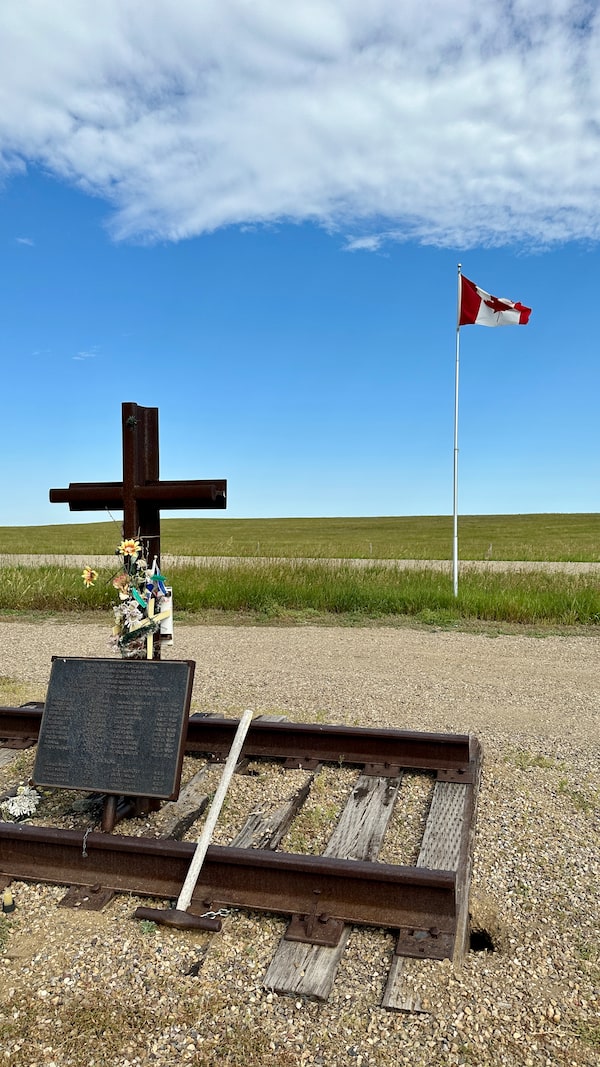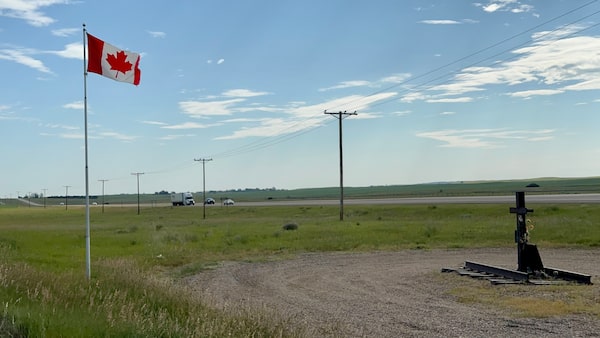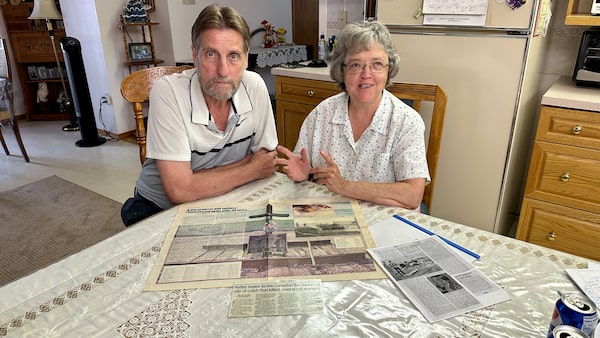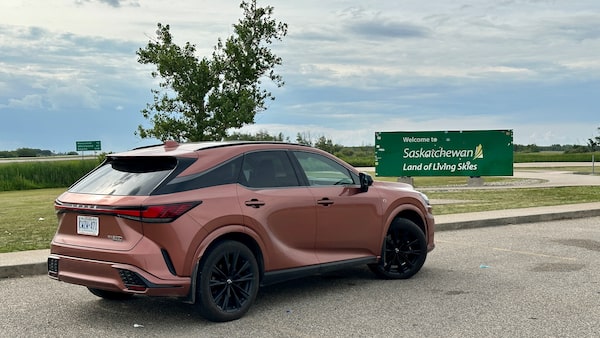A peculiar town and remembering tragedy:
Driving the Trans-Canada Highway through the Prairies

There’s a peculiar town in Saskatchewan named Ernfold. In fact, it’s barely a town, with a population of 18 people and many of its wooden buildings now decrepit and unsafe. It is unique, however, because it lies, quite literally, between the lanes of the Trans-Canada Highway.
Mark Richardson is driving the length of the Trans-Canada Highway from St. John’s to Victoria. This is the fifth of a seven-part series.
Out here on the Prairies, it’s not unusual for the Trans-Canada to have such a wide central median that it can be farmed for hay. It makes the highway safer, because head-on collisions are all but impossible. At Ernfold, however, the lanes split, separating to five kilometres apart at their widest, with plenty of space between them for homes, businesses and churches.
“This was the old highway,” says Christine Bauck, the town’s mayor, pointing to the two westbound lanes that run past her home. On the other side of the asphalt are the Canadian Pacific railway tracks, so the highway could only be widened on the south side. “When they twinned it, back in the day, how could you go right through Ernfold?” she asks, and so the eastbound lanes skirt far away on the other side of town.
Those westbound lanes are just a few metres from where we’re sitting on her porch, so close she’s sunk a large rock in her front lawn to help deflect any tractor-trailers that might stray off the road at speed. “There are so many semi [truck drivers] that fall asleep, and one of these days they’re going to be in my house,” she says.


Left: Ernfold, Sask. mayor Christine Bauck on her porch at home.
Right: A car on the Trans-Canada Highway passes by Christine Bauck’s driveway. A rock seen in the grass beside a tree helps protect her home from a potential collision.
Bauck, 57, and her husband Lynn have no plans to move, however. She manages a highway maintenance crew and drives a snowplow, plus Ernfold is her home, even as it has suffered the same slow malaise over the last few decades that’s afflicted many rural communities. In the mid-1980s, as many as 80 people lived in Ernfold, but as mechanization and consolidation moved work to the cities, the town’s buildings began to empty. The local gas station and store was damaged by a tornado 30 years ago, and then destroyed when a truck hit it a few years later. The local restaurant was struck by lightning and never rebuilt. The post office closed in 1998. The local church was gutted and sold for $1 and is now used for storage.
Even so, Bauck says with more people being able to work remotely, they can move away from the high prices of the cities. Property in Ernfold is available for just a few thousand dollars. “I own the pasture next to here,” she says, “and if I was younger, I would level it and put in a Wendy’s and a Tim Hortons and a car wash, and in 10 years, I would retire. In the winter, when a storm comes in” – when truckers and motorists seek shelter – “it’s a total gong show here.”


Left:A makeshift memorial beside the Trans-Canada Highway in Carberry, Man., at the site of the crash that killed 16 seniors in June, 2023.
Right: Flags at half-mast in Carberry, Man.
The Trans-Canada Highway can be treacherous at any time of the year. A little farther west, in Swift Current, a memorial remembers four hockey players who died when their bus skidded into the ditch on black ice. And of course, a day earlier in Manitoba, I drove past Carberry, where 16 seniors were killed in June when their bus was struck by a tractor-trailer as it crossed the highway. The scorched grass of the inferno was there in the ditch a week later, though the skid marks on the asphalt were fading.

The memorial beside the Trans-Canada Highway to 22 men killed in 1980 near Webb, Sask.Mark Richardson/The Globe and Mail
It’s important for such incidents to be properly remembered, says Marina Gilchrist, whose cousin, Michael Beach, was among 22 men killed in a collision west of Swift Current in 1980. It’s still the worst loss of life ever recorded on the Trans-Canada Highway, when an oncoming car forced the bus Beach was driving across the narrow median of the then-two-lane road, where it was struck by a truck hauling liquid asphalt. “Men were struggling underneath the truck trying to pull themselves out,” the local newspaper reported at the time, quoting a witness. “There were huge flames and explosions every five minutes.”
The passengers were all young men who worked as a steel gang on the railroad, almost all of them from Newfoundland or Manitoba. An inquest in 1981 recommended the Trans-Canada Highway be twinned to the provincial borders, but while a 30-kilometre section that included the crash site was twinned in 1983, the entire highway in Saskatchewan was not twinned until 2008.

The memorial, including the flag pole, beside the Trans-Canada Highway to 22 men killed in 1980 near Webb, Sask.Mark Richardson/The Globe and Mail
For many years, nothing marked the lonely location of the crash, but after lobbying from one of the buses’ eight survivors, a steel cross was erected beside the highway in 2007 by the CPR and local municipalities. Gilchrist wanted more: she wanted a flagpole to fly the Maple Leaf and attract the attention of motorists. In the end, she paid for it herself.

Marina and Mike Gilchrist at home in Medicine Hat, Alta.Mark Richardson/The Globe and Mail
“When the flag wasn’t there, nobody noticed (the memorial),” she says, sitting at her kitchen table an hour away in Medicine Hat, Atla. “Nobody stopped. I don’t think they knew what it was. I wanted people to acknowledge what happened there and remember the people who were killed.”
“In our opinion,” adds her husband, Mike Gilchrist, “we thought they were forgotten too fast.”
In 1980, the first reporter at the scene was John Peters of The Gull Lake Advance. Thirty years later, he recalled in that newspaper that the collision “lingered with me for a long time afterward. Every time you’d drive by, you’d see everything all over again. In time it fades. That memorial is a reminder. It makes you slow down a bit and take notice.”
At Carberry, there was a small patch of mown grass next to the collision site where some flowers had been placed to remember the seniors from Dauphin. I asked around town who was responsible for creating the makeshift site, but nobody knew.
The Lexus RX 500h SUV I’ve been provided for this long drive has so many safety features that I curse at some of them, but I know they can see more and react faster than I can. The proximity warning starts chiming every time I’m in the Tim Hortons drive-through because it thinks I’m too close to the window or the car in front. The camera image on the central display screen shows just how close, and I have to tap the mute button to shut it up when I’m trying to order.

The Lexus RX 500h at the Manitoba/Saskatchewan border.Mark Richardson/The Globe and Mail
That same warning makes itself heard in parking lots when people walk in front of or behind the vehicle, and I curse it and them. The Lexus goes a step further though and, if it’s moving, will actually brake to avoid any collision. Its sensitive radar also detects motorcycles, bicycles and pedestrians at night, and will chime to warn of their presence. If the computer thinks there’ll be a collision, it will apply the brakes or even try to steer around the object if the area is clear.
The truly impressive feature is the vehicle’s lane-detection system, which helps to keep the Lexus in the centre of its lane on the highway. If I were to be distracted or begin to fall asleep, it would steer me straight and warn me against wandering with chimes and vibrations in the steering wheel. A few times, when my lane merged into the lane alongside, I left my hand off the wheel to see if the Lexus would become confused, but it recognized the difference between the solid and broken painted lines and steered into the correct lane, chiding me with more annoying chimes as it did so.


Left: The Trans-Canada Highway near Wolseley, Sask.
Right: The Trans-Canada Highway near Parkbeg, Sask.
There’s even a feature that will recognize the angle of a curve in the road and slow the vehicle as it drives through it. This can be set to three levels of intervention. That lasted about an hour before I switched it off, permanently. What’s the point of driving a nice car if you can’t enjoy it?
Mark Richardson is the author of Canada’s Road: A journey on the Trans-Canada Highway from St. John’s to Victoria (Dundurn).
Read more in this series:
Of moose, a monument and a devastated port town: Driving the Trans-Canada Highway in Newfoundland
A bridge, a ferry and a dot-matrix printer: Driving the Trans-Canada highway through the Maritimes
 Mark Richardson
Mark Richardson